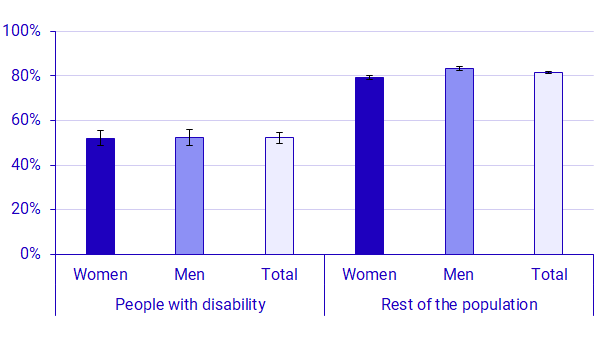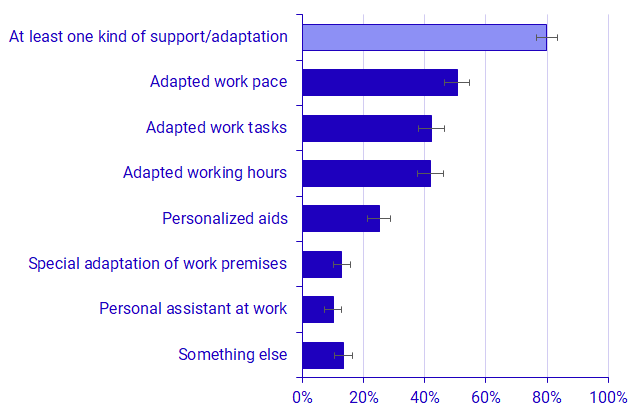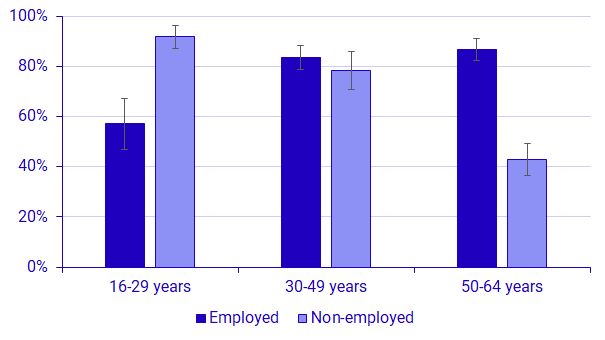The labour market situation for people with disability 2023
Employed people with disability need support and adaptation
Statistical news from Statistics Sweden 2024-04-29 8.00
Among people with disability, approximately half (52 percent) are employed. Many of them need support and adaptation in their workplace.
– Six out of ten employed people with disability have a reduced ability to work. Of these, 80 percent need support and adaptation to be able to work, says Marc Doppelbauer, Analyst at Statistics Sweden.
On behalf of the Government, Statistics Sweden has carried out a survey on the labour market situation for people with disability. The questions were asked directly after the Labour Force Survey (LFS).
In the survey, just under 11 percent of the population aged 16–65 years state to have a disability. Of those, 72 percent consider that their disability partly or fully reduces their ability to work. Among employed people with disability, just over 61 percent have a reduced ability to work. The corresponding proportion among non-employed people is 83 percent.
The employment rate of people with disability is 52 percent, which is lower than the employment rate of 81 percent for the rest of the population.

There is no significant difference in employment rate between women and men with disability, regardless of whether their ability to work is reduced or not.
Eight out of ten employed people with reduced ability to work need support and adaptation
80 percent of employed people with a disability that reduces their ability to work need at least one support and adaptation measure.

The need for support and adaptation is highest in the 50–65 age group. Most employed people have a need for adapted work pace, adapted work tasks and adapted working hours.
– Of the employed people with a disability that reduces their ability to work who need at least one support and adaptation measure, 83 percent have also received at least one measure. This means that 17 percent do not receive the support and adaptation they need, says Marc Doppelbauer.
Nine out of ten non-employed young people with reduced ability to work need support and adaptation
Among non-employed people with disability, the proportion who have a very reduced ability to work is considerably higher than among employed people with disability.
66 percent of non-employed people with disability and reduced ability to work believe that they would be able to work if they received at least one support and adaptation measure. In contrast to the employed, there is a higher proportion of non-employed young people who need support and adaptation compared to other age groups. In the age group 16–29, 92 percent need at least one support and adaptation measure to be able to work.

Non-employed people with disability with reduced ability to work need personalized aids, special adaptation of work premises and a personal assistant at work to a greater extent than employed people.
Definitions and explanations
The labour market situation for people with disability 2023
The survey includes people aged 16–65 years who are in Sweden’s population register. The sample is selected by means of a question concerning disability that is asked directly after the Labour Force Survey (LFS). People who indicate that they have a disability are asked whether their disability reduces their ability to work. Those who have a reduced ability to work are also asked questions about whether they have a need for support or adaptation to be able to work, as well as (for those who are employed) whether they have received it.
People with disability include those who answered “Yes” to the following question: “Do you have a disability? It can, for example, be a physical, psychological, cognitive, intellectual, or neuropsychiatric disability.”
The results for employment and unemployment in the total population presented in this report differ from the official LFS statistics since the sample for this survey is limited to the age group 16-65 and the estimation procedure is different from the LFS.
Publication
Feel free to use the facts from this statistical news but remember to state Source: Statistics Sweden.
